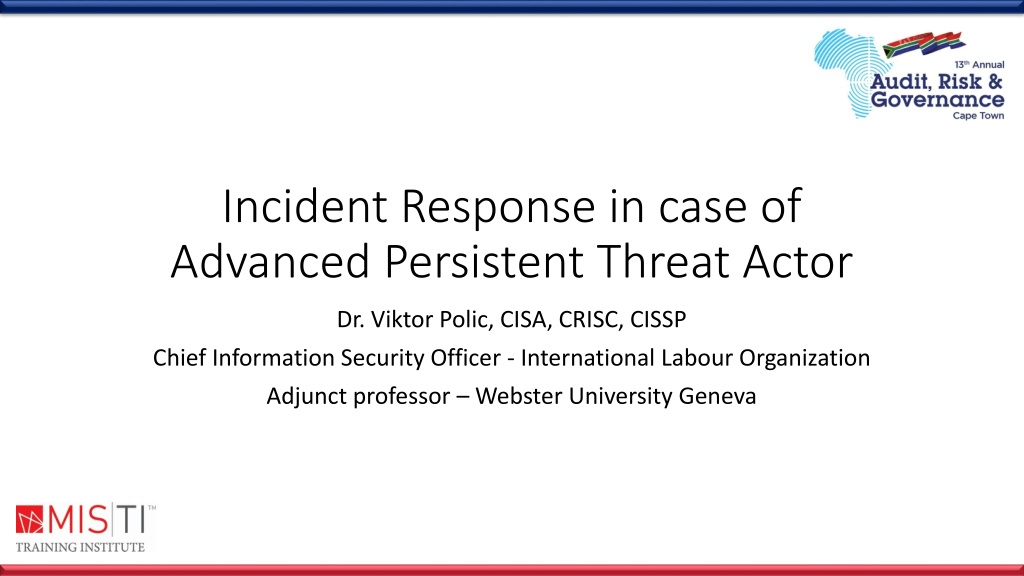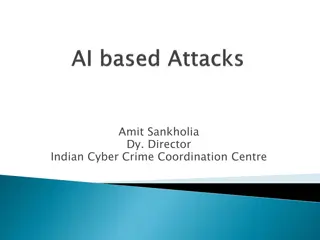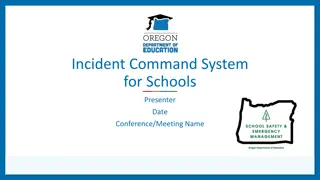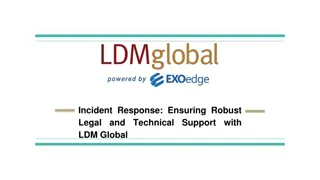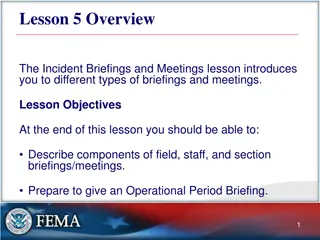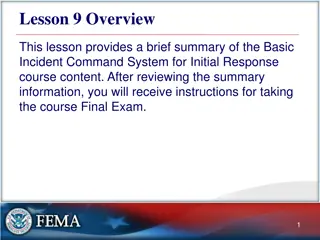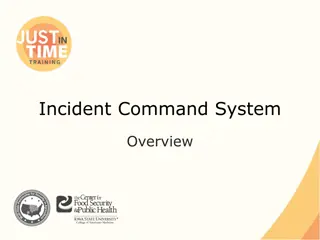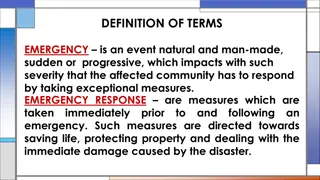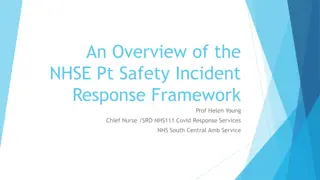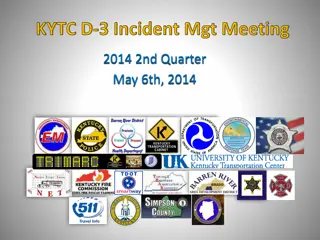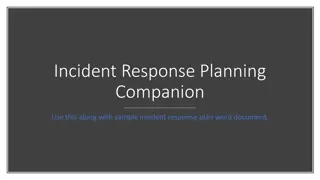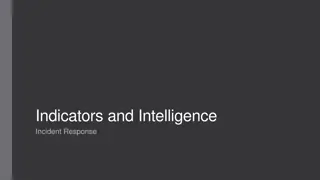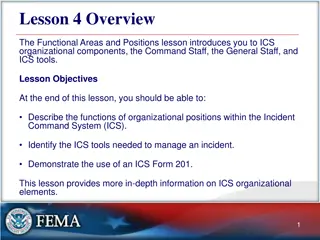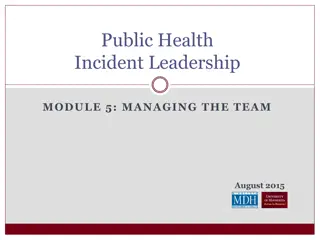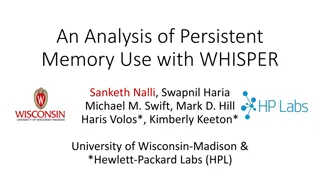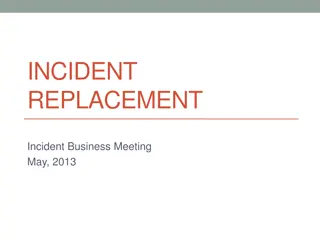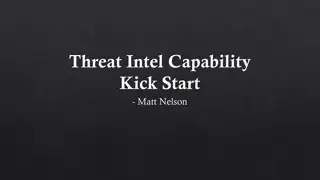Advanced Persistent Threat Incident Response: Case Study and Insights
An in-depth look at advanced persistent threat (APT) characteristics and incident response strategies, based on a case study timeline from 2016. Dr. Viktor Polic, a seasoned Chief Information Security Officer, shares key learnings and actions taken during the response to a sophisticated cyber attack. The case study highlights the importance of collaboration, forensic analysis, malware detection, impact assessment, and policy improvements in dealing with APT incidents.
Download Presentation

Please find below an Image/Link to download the presentation.
The content on the website is provided AS IS for your information and personal use only. It may not be sold, licensed, or shared on other websites without obtaining consent from the author. Download presentation by click this link. If you encounter any issues during the download, it is possible that the publisher has removed the file from their server.
E N D
Presentation Transcript
Incident Response in case of Advanced Persistent Threat Actor Dr. Viktor Polic, CISA, CRISC, CISSP Chief Information Security Officer - International Labour Organization Adjunct professor Webster University Geneva
The views expressed herein are those of the author and do not necessarily reflect the views of the International Labour Organization. Dr. Viktor Polic, CISA, CRISC, CISSP 2
APT Characteristics Use of complex intrusion and data exfiltration technologies. Often custom designed and communicating with remote command and control infrastructure. Targeted well organized intelligence campaigns to collect knowledge about victim organization, its employees, and business processes. Advanced Persistent Extended period of attacks in sequential manner, involves evolving technologies and tactics to avoid detection and countermeasures. Threat actors apply configuration and change management Threats Threat actors are highly motivated and resourced. Could involve multiple proxy actors. Dr. Viktor Polic, CISA, CRISC, CISSP 3
Case study: Incident response timeline 2016-07 IoC received from external partner Incident confirmed on 1 server Sample submitted for analysis to 3 external partners Malware removed from the server Forensic analysis started internally New IoC discovered and detected on the 2nd server Coordination with IA and PROC for external services New samples submitted to external partners Meeting with business owners to assess the impact 2016-09 Investigation expanded to backup images of 3 decommissioned servers Additional external resources acquired for analysis New IoCs received from external partners, incidents detected New images analyzed and malware detected Samples submitted for analysis Initially infected servers detected 2016-11 Impact report submitted to SMT Malware removed manually from non- protected servers Closing technical report presented to internal teams Final anonymized report submitted to external partners and peers 1 2 3 4 5 Months 2016-10 More malware samples extracted and submitted for analysis Reports confirm code similarities and attribute to APT3 Initially infected PCs identified All communication channels blocked Detailed report submitted to authorities Internal policies and procedures updated to improve incident detection and response Incident coordination role assigned Internal MOU signed between InfoSec and IA for collaboration in digital forensics Malware removed from all protected servers 2016-08 Forensic images submitted to 2 external partners Reports received with new IoCs Malware detected on 2 more servers Images submitted to external partners for forensic analysis Internal analysis expended to several technical teams Coordination with IA and Investigation to analyze potential internal involvement Meeting with external partners, authorities, coordination with legal, IA, senior management Dr. Viktor Polic, CISA, CRISC, CISSP 4
Case study of APT3 or Pirpi Cyber-espionage operations against industrial targets, governments, public-sector. Ability to acquire or develop 0-day exploits. Rapid adoption of disclosed vulnerabilities and update deployed malware. Uses steganography to conceal malware. Uses custom cryptography to establish communication. Uses specific command and control (C&C) infrastructure for each target. Reference https://attack.mitre.org/wiki/Group/G0022 Dr. Viktor Polic, CISA, CRISC, CISSP 5
APT3 Attack tactics Engaging target employees via social-media to build trust before phishing campaigns. Phishing tactics phishing campaign to multiple targets with brief messages using crafted PDF documents exploiting Adobe Flash 0-days First stage Pirpi backdoor. Provides remote shell with local search and download functions. Usually observed executing via DLL load-order hijacking (legitimate exe calls malicious DLL) Second stage MofRAT backdoor. Advanced Remote Access Trojan (RAT) with detection avoidance (VM detection, sandbox detection), control flow and data obfuscation. Installed as a system service. When run the RAT loads wmildap.mof that contains decryption key and a domain name of the C&C. Target acquisition Initial access System exploit and information gathering Maintaining access and covering tracks Dr. Viktor Polic, CISA, CRISC, CISSP 6
APT3 Communication with C&C The older variant uses Microsoft secure channel API from sspicli.dll on port 443 and MS CryptoAPI to create a certificate store. It is able to tunnel through victim s proxy server. It could also encode and randomize initial beacon to avoid detection. Newer samples use the OpenSSL library instead of MS secure channel. They are larger because the OpenSSL is statically compiled. Network traffic is difficult to detect since C&C infrastructure evolves more dynamically than threat intelligence and indicators of compromise (IoC) Dr. Viktor Polic, CISA, CRISC, CISSP 7
APT3 Functionality RAT can fork interactive shell (cmd.exe), download and upload files, update configuration, and alter communication parameters. Provides interactive remote sessions as well as batch processing. Recent samples provide anti-forensic functionality Provides Windows Registry manipulation. Provides memory manipulation and debugger hooks to prevent reverse engineering. Contains handles to windows user desktop to interact with end-users. Dr. Viktor Polic, CISA, CRISC, CISSP 8
APT3 Code analysis of a 0-day UPS.EXE matches the common portable executable (PE) format. It uses Import address table for DLLs: OpenSSL, Kernel32.dll, advapi32.dll, msvcr90.dll, ws2_32.dll, shlwapi.dll, user32.dll Still detected by 31 out of 55 anti-malware products referenced by Virustotal Reference: https://www.virustotal.com/en/file/4b0eef64b378c3101551662170f3b6ee577b0d525afba93e17 5b9b06fd99e199/analysis/ Dr. Viktor Polic, CISA, CRISC, CISSP 9
Case study APT3 Attack flow Dr. Viktor Polic, CISA, CRISC, CISSP 10
Case study: Impact summary 7 servers and 2 PCs compromised during 3 years long campaign 3 IT administrator accounts compromised 3 IT service accounts compromised 10 zero-day malware binaries identified 3 entry points to C&C infrastructure identified at 3 ISPs (2 countries) 1 zero-day could be sold for 300 000 USD Ref:https://zerodium.com/program.html Dr. Viktor Polic, CISA, CRISC, CISSP 11
APT Countermeasures Prevention Policy Technology use, Incident reporting and response, Identity management Awareness End-user education on risk avoidance, Anti-phishing simulations, IT administrators training Vulnerability mitigation Computer hardening, Patch management, Configuration management, Access control with segregation of roles, Application whitelisting, Network segregation, Multi-factor authentication Data Backup Dr. Viktor Polic, CISA, CRISC, CISSP 12
APT Countermeasures Detection Heuristic based and reputation based file and process monitoring Memory access and usage monitoring Egress and Ingress network traffic monitoring with subscription to threat intelligence feeds Behavioral analytics File integrity monitoring Detecting lateral moves using honeypots/deception systems Forensic analysis Dr. Viktor Polic, CISA, CRISC, CISSP 13
APT Countermeasures Analysis Malware identification Static and Dynamic code analysis Network traffic analysis Operating System log analysis Authentication log analysis Business applications log analysis Indicator of Compromise (IoC) comparison Dr. Viktor Polic, CISA, CRISC, CISSP 14
APT Countermeasures Corrective actions Malware clean/quarantine Files restores System restores/reinstallation Anti-malware/IDS updates with new signatures IoC feedback/exchange Awareness program updates Policies, procedures, baselines updates Dr. Viktor Polic, CISA, CRISC, CISSP 15
Improved preparedness Strategic risk update We are targeted by highly determined and resourced threat actor! Incident management and coordination channels improved to reduce time/cost of incident response. Internal MOU signed between InfoSec and Internal Audit. Financial structure for resourcing incident response developed. Partnership for incident response with external commercial and peer experts formalized. Security Operation Centers established. Continuous communication with cybersecurity authorities established. Continuous monitoring process developed and assigned to InfoSec. Dr. Viktor Polic, CISA, CRISC, CISSP 16
Q&A https://cybersymbiosis.com/ vpolic@cybersymbiosis.com https://ch.linkedin.com/in/viktor-polic-891a1a145 https://twitter.com/ViktorPolic Dr. Viktor Polic, CISA, CRISC, CISSP 17
